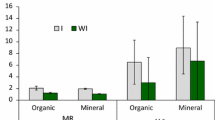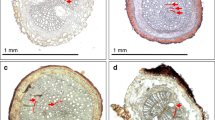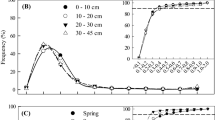Abstract
Using a new approach involving one-time measurements of radiocarbon (14C) in fine (<2 mm diameter) root tissues we have directly measured the mean age of fine-root carbon. We find that the carbon making up the standing stock of fine roots in deciduous and coniferous forests of the eastern United States has a mean age of 3–18 years for live fine roots, 10–18 years for dead fine roots, and 3–18 years for mixed live+dead fine roots. These 14C-derived mean ages represent the time C was stored in the plant before being allocated for root growth, plus the average lifespan (for live roots), plus the average time for the root to decompose (for dead roots and mixtures). Comparison of the 14C content of roots known to have grown within 1 year with the 14C of atmospheric CO2 for the same period shows that root tissues are derived from recently fixed carbon, and the storage time prior to allocation is <2 years and likely <1 year. Fine-root mean ages tend to increase with depth in the soil. Live roots in the organic horizons are made of C fixed 3–8 years ago compared with 11–18 years in the mineral B horizons. The mean age of C in roots increases with root diameter and also is related to branching order. Our results differ dramatically from previous estimates of fine-root mean ages made using mass balance approaches and root-viewing cameras, which generally report life spans (mean ages for live roots) of a few months to 1–2 years. Each method for estimating fine-root dynamics, including this new radiocarbon method, has biases. Root-viewing approaches tend to emphasize more rapidly cycling roots, while radiocarbon ages tend to reflect those components that persist longest in the soil. Our 14C-derived estimates of long mean ages can be reconciled with faster estimates only if fine-root populations have varying rates of root mortality and decomposition. Our results indicate that a standard definition of fine roots, as those with diameters of <2 mm, is inadequate to determine the most dynamic portion of the root population. Recognition of the variability in fine-root dynamics is necessary to obtain better estimates of belowground C inputs.
Similar content being viewed by others
Author information
Authors and Affiliations
Additional information
Electronic Publication
Rights and permissions
About this article
Cite this article
Gaudinski, J., Trumbore, S., Davidson, E. et al. The age of fine-root carbon in three forests of the eastern United States measured by radiocarbon. Oecologia 129, 420–429 (2001). https://doi.org/10.1007/s004420100746
Received:
Accepted:
Published:
Issue Date:
DOI: https://doi.org/10.1007/s004420100746




